Abstract
One century after the clinical introduction of cocaine, local anesthesia remains the most important method of pain control in dentistry. Many local anesthetics have been marketed since 1884, and it is likely that attempts to produce drugs that enhance anesthetic efficacy, reduce systemic and local toxicity, and increase nociceptive selectivity, will continue. In addition, new methods of drug administration have been and will be developed to achieve these goals. Of fundamental importance to such improvements are investigations into the pharmacology of drugs with local anesthetic activity and anatomical and physiologic studies pertaining to the reasons why local anesthetics sometimes fail to achieve desired results. This paper reviews recent advances in our understanding of these drugs and their clinical use.
Full text
PDF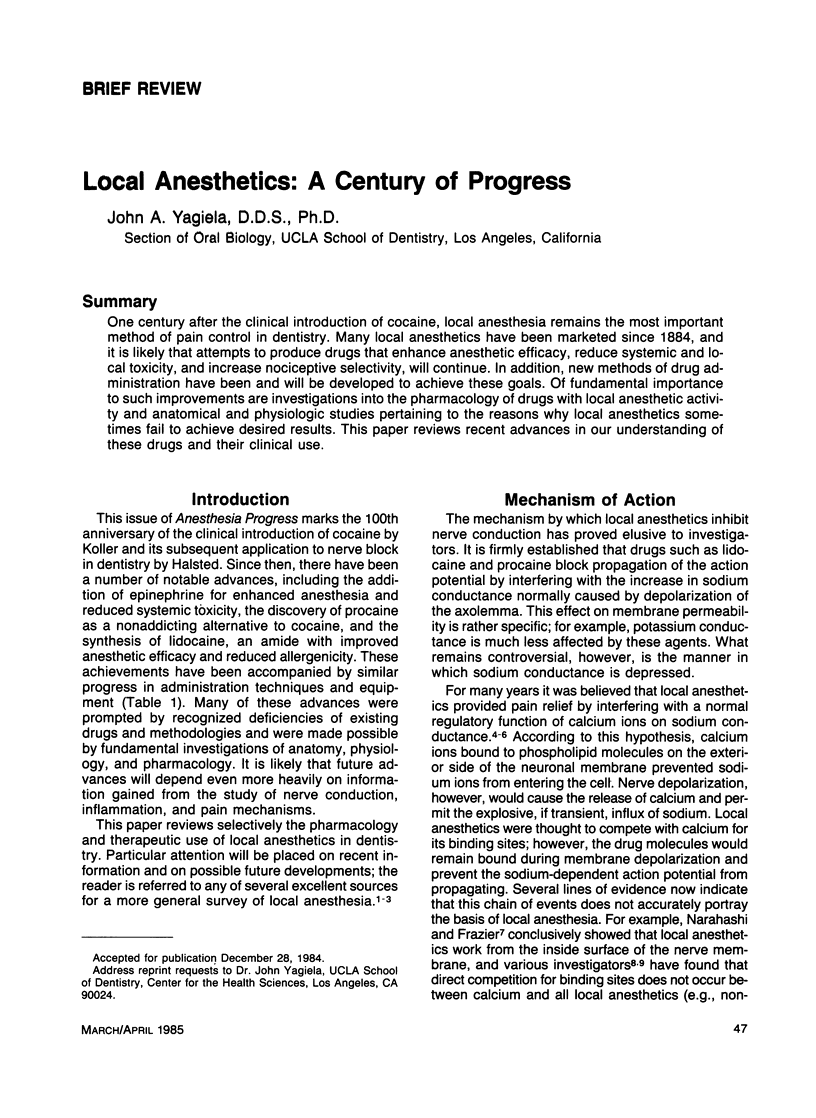


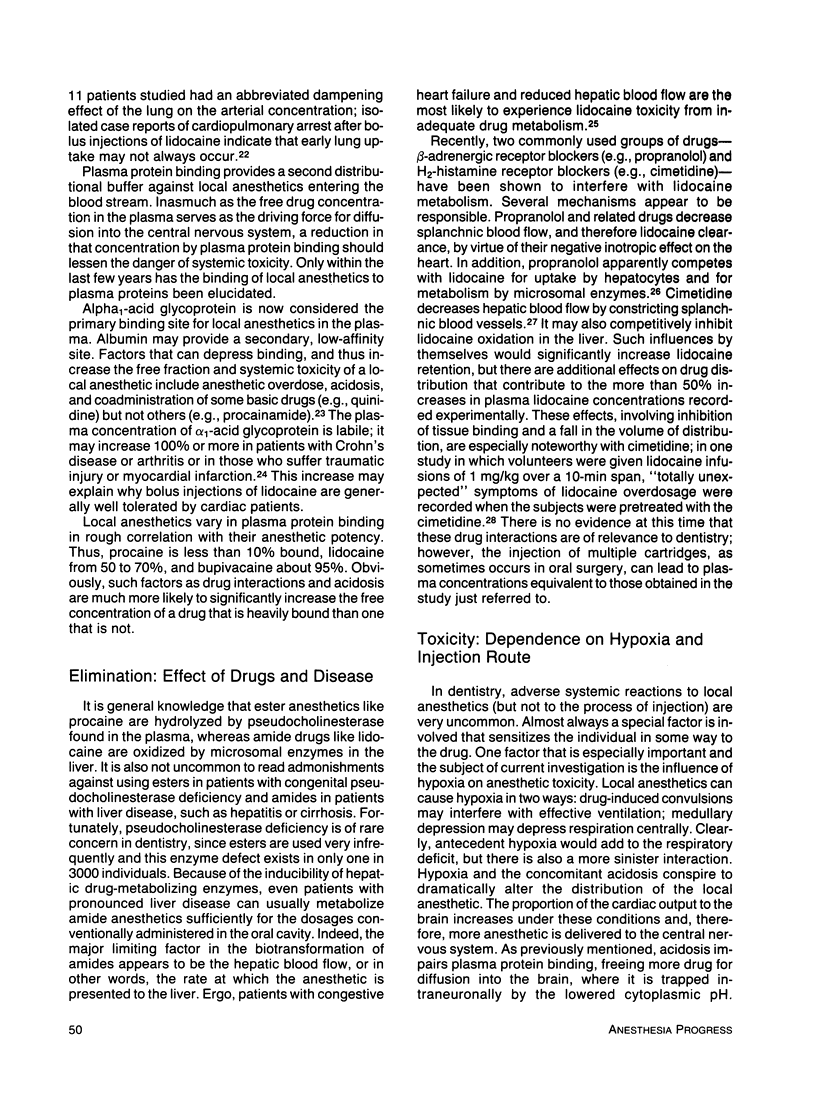
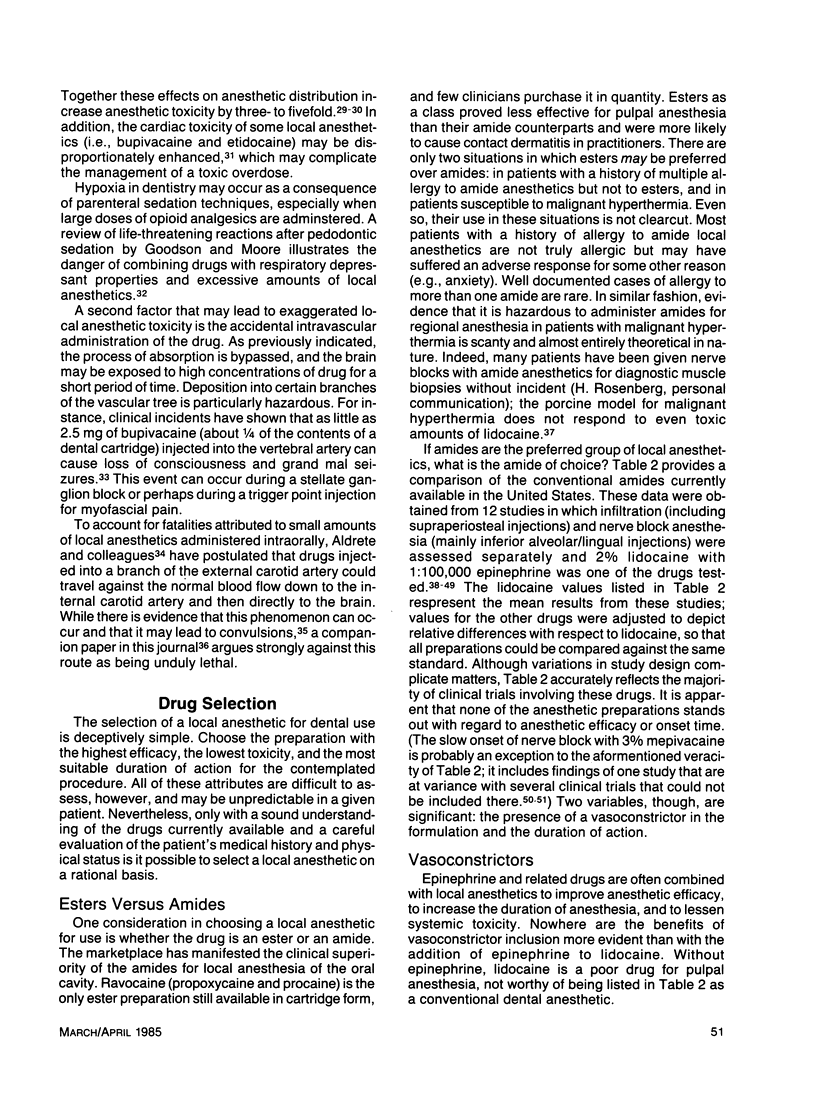

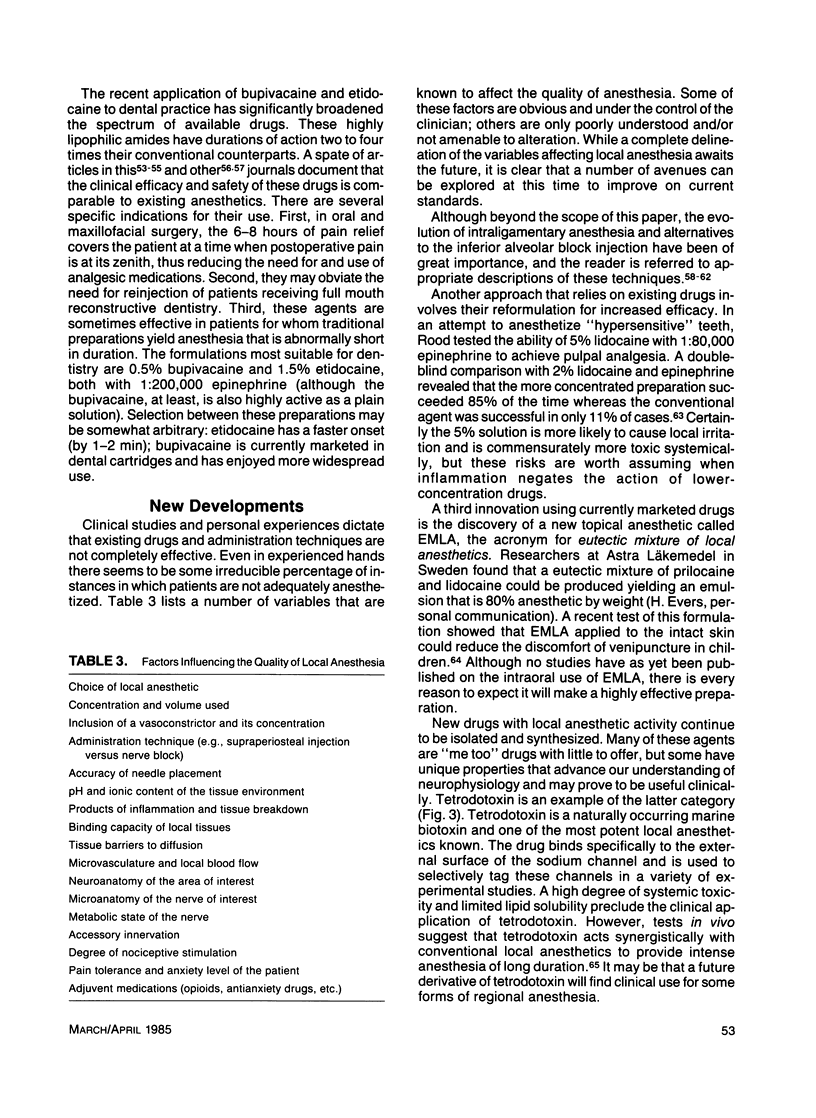
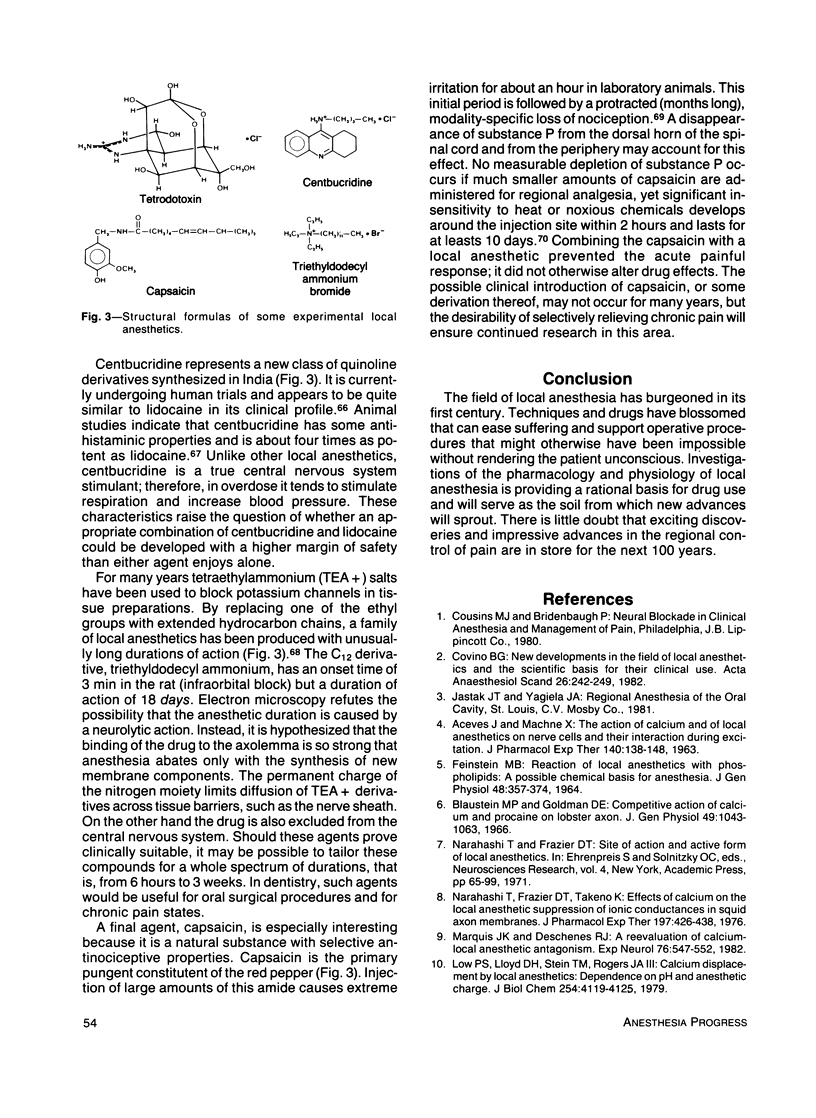
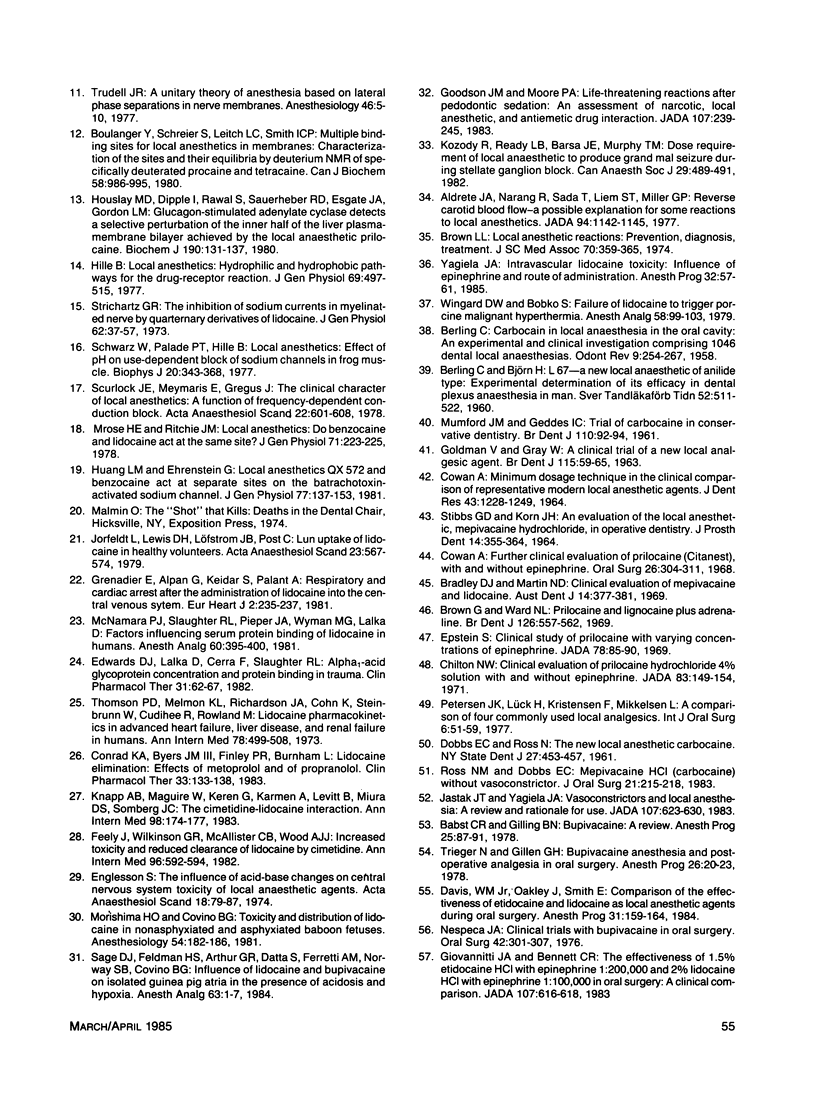

Images in this article
Selected References
These references are in PubMed. This may not be the complete list of references from this article.
- ACEVES J., MACHNE X. The action of calcium and of local anesthetics on nerve cells, and their interaction during excitation. J Pharmacol Exp Ther. 1963 May;140:138–148. [PubMed] [Google Scholar]
- Adams H. J., Blair M. R., Jr, Takman B. H. The local anesthetic activity of tetrodotoxin alone and in combination with vasoconstrictors and local anesthetics. Anesth Analg. 1976 Jul-Aug;55(4):568–573. [PubMed] [Google Scholar]
- Akinosi J. O. A new approach to the mandibular nerve block. Br J Oral Surg. 1977 Jul;15(1):83–87. doi: 10.1016/0007-117x(77)90011-7. [DOI] [PubMed] [Google Scholar]
- Aldrete J. A., Narang R., Sada T., Tan Liem S., Miller G. P. Reverse carotid blood flow--a possible explanation for some reactions to local anesthetics. J Am Dent Assoc. 1977 Jun;94(6):1142–1145. doi: 10.14219/jada.archive.1977.0365. [DOI] [PubMed] [Google Scholar]
- Babst C. R., Gilling B. N. Bupivacaine: a review. Anesth Prog. 1978 May-Jun;25(3):87–91. [PMC free article] [PubMed] [Google Scholar]
- Blaustein M. P., Goldman D. E. Competitive action of calcium and procaine on lobster axon. A study of the mechanism of action of certain local anesthetics. J Gen Physiol. 1966 May;49(5):1043–1063. doi: 10.1085/jgp.49.5.1043. [DOI] [PMC free article] [PubMed] [Google Scholar]
- Boulanger Y., Schreier S., Leitch L. C., Smith I. C. Multiple binding sites for local anesthetics in membranes: characterization of the sites and their equilibria by deuterium NMR of specifically deuterated procaine and tetracaine. Can J Biochem. 1980 Oct;58(10):986–995. doi: 10.1139/o80-134. [DOI] [PubMed] [Google Scholar]
- Bradley D. J., Martin N. D. Clinical evaluation of mepivacaine and lidocaine. Aust Dent J. 1969 Dec;14(6):377–381. doi: 10.1111/j.1834-7819.1969.tb02291.x. [DOI] [PubMed] [Google Scholar]
- Brown G., Ward N. L. Prilocaine and lignocaine plus adrenaline. A clinical comparison. Br Dent J. 1969 Jun 17;126(12):557–562. [PubMed] [Google Scholar]
- Brown L. L. Local anesthetic reactions: prevention, diagnosis, treatment. J S C Med Assoc. 1974 Nov;70(11):359–365. [PubMed] [Google Scholar]
- COWAN A. MINIMUM DOSAGE TECHNIQUE IN THE CLINICAL COMPARISON OF REPRESENTATIVE MODERN LOCAL ANESTHETIC AGENTS. J Dent Res. 1964 Nov-Dec;43:1228–1249. doi: 10.1177/00220345640430063401. [DOI] [PubMed] [Google Scholar]
- Chilton N. W. Clinical evaluation of prilocaine hydrochloride 4 percent solution with and without epinephrine. J Am Dent Assoc. 1971 Jul;83(1):149–154. doi: 10.14219/jada.archive.1971.0288. [DOI] [PubMed] [Google Scholar]
- Conrad K. A., Byers J. M., 3rd, Finley P. R., Burnham L. Lidocaine elimination: effects of metoprolol and of propranolol. Clin Pharmacol Ther. 1983 Feb;33(2):133–138. doi: 10.1038/clpt.1983.20. [DOI] [PubMed] [Google Scholar]
- Covino B. G. New developments in the field of local anesthetics and the scientific basis for their clinical use. Acta Anaesthesiol Scand. 1982 Jun;26(3):242–249. doi: 10.1111/j.1399-6576.1982.tb01763.x. [DOI] [PubMed] [Google Scholar]
- Cowan A. Further clinical evaluation of prilocaine (Citanest), with and without epinephrine. Oral Surg Oral Med Oral Pathol. 1968 Sep;26(3):304–311. doi: 10.1016/0030-4220(68)90400-3. [DOI] [PubMed] [Google Scholar]
- Davis W. M., Jr, Oakley J., Smith E. Comparison of the effectiveness of etidocaine and lidocaine as local anesthetic agents during oral surgery. Anesth Prog. 1984 Jul-Aug;31(4):159–164. [PMC free article] [PubMed] [Google Scholar]
- Edwards D. J., Lalka D., Cerra F., Slaughter R. L. Alpha1-acid glycoprotein concentration and protein binding in trauma. Clin Pharmacol Ther. 1982 Jan;31(1):62–67. doi: 10.1038/clpt.1982.10. [DOI] [PubMed] [Google Scholar]
- Ehrenström Reiz G. M., Reiz S. L. EMLA--a eutectic mixture of local anaesthetics for topical anaesthesia. Acta Anaesthesiol Scand. 1982 Dec;26(6):596–598. doi: 10.1111/j.1399-6576.1982.tb01822.x. [DOI] [PubMed] [Google Scholar]
- Eldridge D. J., Rood J. P. A double-blind trial of 5 per cent lignocaine solution. Br Dent J. 1977 Feb 15;142(4):129–130. doi: 10.1038/sj.bdj.4803877. [DOI] [PubMed] [Google Scholar]
- Englesson S. The influence of acid-base changes on central nervous system toxicity of local anaesthetic agents. I. An experimental study in cats. Acta Anaesthesiol Scand. 1974;18(2):79–87. doi: 10.1111/j.1399-6576.1974.tb00846.x. [DOI] [PubMed] [Google Scholar]
- Epstein S. Clinical study of prilocaine with varying concentrations of epinephrine. J Am Dent Assoc. 1969 Jan;78(1):85–90. doi: 10.14219/jada.archive.1969.0019. [DOI] [PubMed] [Google Scholar]
- FEINSTEIN M. B. REACTION OF LOCAL ANESTHETICS WITH PHOSPHOLIPIDS. A POSSIBLE CHEMICAL BASIS FOR ANESTHESIA. J Gen Physiol. 1964 Nov;48:357–374. doi: 10.1085/jgp.48.2.357. [DOI] [PMC free article] [PubMed] [Google Scholar]
- Feely J., Wilkinson G. R., McAllister C. B., Wood A. J. Increased toxicity and reduced clearance of lidocaine by cimetidine. Ann Intern Med. 1982 May;96(5):592–594. doi: 10.7326/0003-4819-96-5-592. [DOI] [PubMed] [Google Scholar]
- Giovannitti J. A., Bennett C. R. The effectiveness of 1.5% etidocaine HCl with epinephrine 1:200,000 and 2% lidocaine HCl with epinephrine 1:100,000 in oral surgery: a clinical comparison. J Am Dent Assoc. 1983 Oct;107(4):616–618. doi: 10.14219/jada.archive.1983.0299. [DOI] [PubMed] [Google Scholar]
- Goodson J. M., Moore P. A. Life-threatening reactions after pedodontic sedation: an assessment of narcotic, local anesthetic, and antiemetic drug interaction. J Am Dent Assoc. 1983 Aug;107(2):239–245. doi: 10.14219/jada.archive.1983.0225. [DOI] [PubMed] [Google Scholar]
- Gow-Gates G. A. Mandibular conduction anesthesia: a new technique using extraoral landmarks. Oral Surg Oral Med Oral Pathol. 1973 Sep;36(3):321–328. doi: 10.1016/0030-4220(73)90208-9. [DOI] [PubMed] [Google Scholar]
- Grenadier E., Alpan G., Keidar S., Palant A. Respiratory and cardiac arrest after the administration of lidocaine into the central venous system. Eur Heart J. 1981 Jun;2(3):235–237. doi: 10.1093/oxfordjournals.eurheartj.a061199. [DOI] [PubMed] [Google Scholar]
- Hayes A. G., Tyers M. B. Effects of capsaicin on nociceptive heat, pressure and chemical thresholds and on substance P levels in the rat. Brain Res. 1980 May 12;189(2):561–564. doi: 10.1016/0006-8993(80)90369-8. [DOI] [PubMed] [Google Scholar]
- Hille B. Local anesthetics: hydrophilic and hydrophobic pathways for the drug-receptor reaction. J Gen Physiol. 1977 Apr;69(4):497–515. doi: 10.1085/jgp.69.4.497. [DOI] [PMC free article] [PubMed] [Google Scholar]
- Houslay M. D., Dipple I., Rawal S., Sauerheber R. D., Esgate J. A., Gordon L. M. Glucagon-stimulated adenylate cyclase detects a selective perturbation of the inner half of the liver plasma-membrane bilayer achieved by the local anaesthetic prilocaine. Biochem J. 1980 Jul 15;190(1):131–137. doi: 10.1042/bj1900131. [DOI] [PMC free article] [PubMed] [Google Scholar]
- Huang L. M., Ehrenstein G. Local anesthetics QX 572 and benzocaine act at separate sites on the batrachotoxin-activated sodium channel. J Gen Physiol. 1981 Feb;77(2):137–153. doi: 10.1085/jgp.77.2.137. [DOI] [PMC free article] [PubMed] [Google Scholar]
- Jastak J. T., Yagiela J. A. Vasoconstrictors and local anesthesia: a review and rationale for use. J Am Dent Assoc. 1983 Oct;107(4):623–630. doi: 10.14219/jada.archive.1983.0307. [DOI] [PubMed] [Google Scholar]
- Jorfeldt L., Lewis D. H., Löfström J. B., Post C. Lung uptake of lidocaine in healthy volunteers. Acta Anaesthesiol Scand. 1979 Dec;23(6):567–574. doi: 10.1111/j.1399-6576.1979.tb01488.x. [DOI] [PubMed] [Google Scholar]
- Knapp A. B., Maguire W., Keren G., Karmen A., Levitt B., Miura D. S., Somberg J. C. The cimetidine-lidocaine interaction. Ann Intern Med. 1983 Feb;98(2):174–177. doi: 10.7326/0003-4819-98-2-174. [DOI] [PubMed] [Google Scholar]
- Kozody R., Ready L. B., Barsa J. E., Murphy T. M. Dose requirement of local anaesthetic to produce grand mal seizure during stellate ganglion block. Can Anaesth Soc J. 1982 Sep;29(5):489–491. doi: 10.1007/BF03009415. [DOI] [PubMed] [Google Scholar]
- Low P. S., Lloyd D. H., Stein T. M., Rogers J. A., 3rd Calcium displacement by local anesthetics. Dependence on pH and anesthetic charge. J Biol Chem. 1979 May 25;254(10):4119–4125. [PubMed] [Google Scholar]
- Marquis J. K., Deschenes R. J. A reevaluation of calcium-local anesthetic antagonism. Exp Neurol. 1982 Jun;76(3):547–552. doi: 10.1016/0014-4886(82)90123-6. [DOI] [PubMed] [Google Scholar]
- McNamara P. J., Slaughter R. L., Pieper J. A., Wyman M. G., Lalka D. Factors influencing serum protein binding of lidocaine in humans. Anesth Analg. 1981 Jun;60(6):395–400. [PubMed] [Google Scholar]
- Morishima H. O., Covino B. G. Toxicity and distribution of lidocaine in nonasphyxiated and asphyxiated baboon fetuses. Anesthesiology. 1981 Mar;54(3):182–186. doi: 10.1097/00000542-198103000-00002. [DOI] [PubMed] [Google Scholar]
- Mrose H. E., Ritchie J. M. Local Anesthetics: do benzocaine and lidocaine act at the same single site? J Gen Physiol. 1978 Feb;71(2):223–225. [PMC free article] [PubMed] [Google Scholar]
- Narahashi T., Frazier D. T. Site of action and active form of local anesthetics. Neurosci Res (N Y) 1971;4:65–99. doi: 10.1016/b978-0-12-512504-8.50009-3. [DOI] [PubMed] [Google Scholar]
- Narahashi T., Frazier D. T., Takeno K. Effects of calcium on the local anesthetic suppression of ionic conductances in squid axon membranes. J Pharmacol Exp Ther. 1976 May;197(2):426–438. [PubMed] [Google Scholar]
- Nespeca J. A. Clinical trials with bupivacaine in oral surgery. Oral Surg Oral Med Oral Pathol. 1976 Sep;42(3):301–307. doi: 10.1016/0030-4220(76)90163-8. [DOI] [PubMed] [Google Scholar]
- Patnaik G. K., Dhawan B. N. Pharmacological study of 4-N-butylamino-1,2,3,4-tetrahydroacridine hydrochloride (Centbucridine)--a new local anaesthetic agent. Indian J Exp Biol. 1982 Apr;20(4):330–333. [PubMed] [Google Scholar]
- Petersen J. K., Lück H., Kristensen F., Mikkelsen L. A comparison of four commonly used local analgesics. Int J Oral Surg. 1977 Feb;6(1):51–59. doi: 10.1016/s0300-9785(77)80059-8. [DOI] [PubMed] [Google Scholar]
- ROSS N. M., DOBBS E. C. Mepivacaine HCI (Carbocaine) without vasoconstrictor. J Oral Surg Anesth Hosp Dent Serv. 1963 May;21:215–219. [PubMed] [Google Scholar]
- Sage D. J., Feldman H. S., Arthur G. R., Datta S., Ferretti A. M., Norway S. B., Covino B. G. Influence of lidocaine and bupivacaine on isolated guinea pig atria in the presence of acidosis and hypoxia. Anesth Analg. 1984 Jan;63(1):1–7. [PubMed] [Google Scholar]
- Samsi A. B., Bhalerao R. A., Shah S. C., Mody B. B., Paul T., Satoskar R. S. Evaluation of centbucridine as a local anesthetic. Anesth Analg. 1983 Jan;62(1):109–111. [PubMed] [Google Scholar]
- Schwarz W., Palade P. T., Hille B. Local anesthetics. Effect of pH on use-dependent block of sodium channels in frog muscle. Biophys J. 1977 Dec;20(3):343–368. doi: 10.1016/S0006-3495(77)85554-9. [DOI] [PMC free article] [PubMed] [Google Scholar]
- Scurlock J. E., Curtis B. M. Tetraethylammonium derivatives: ultralong-acting local anesthetics? Anesthesiology. 1981 Apr;54(4):265–269. [PubMed] [Google Scholar]
- Scurlock J. E., Meymaris E., Gregus J. The clinical character of local anesthetics: a function of frequency-dependent conduction block. Acta Anaesthesiol Scand. 1978;22(6):601–608. doi: 10.1111/j.1399-6576.1978.tb01343.x. [DOI] [PubMed] [Google Scholar]
- Smith G. N., Walton R. E., Abbott B. J. Clinical evaluation of periodontal ligament anesthesia using a pressure syringe. J Am Dent Assoc. 1983 Dec;107(6):953–956. doi: 10.14219/jada.archive.1983.0357. [DOI] [PubMed] [Google Scholar]
- Strichartz G. R. The inhibition of sodium currents in myelinated nerve by quaternary derivatives of lidocaine. J Gen Physiol. 1973 Jul;62(1):37–57. doi: 10.1085/jgp.62.1.37. [DOI] [PMC free article] [PubMed] [Google Scholar]
- Thomson P. D., Melmon K. L., Richardson J. A., Cohn K., Steinbrunn W., Cudihee R., Rowland M. Lidocaine pharmacokinetics in advanced heart failure, liver disease, and renal failure in humans. Ann Intern Med. 1973 Apr;78(4):499–508. doi: 10.7326/0003-4819-78-4-499. [DOI] [PubMed] [Google Scholar]
- Trieger N., Gillen G. H. Bupivacaine anesthesia and post-operative analgesia in oral surgery. Anesth Prog. 1979 Jan-Feb;26(1):20–23. [PMC free article] [PubMed] [Google Scholar]
- Trudell J. R. A unitary theory of anesthesia based on lateral phase separations in nerve membranes. Anesthesiology. 1977 Jan;46(1):5–10. doi: 10.1097/00000542-197701000-00003. [DOI] [PubMed] [Google Scholar]
- Wingard D. W., Bobko S. Failure of lidocaine to trigger porcine malignant hyperthermia. Anesth Analg. 1979 Mar-Apr;58(2):99–103. doi: 10.1213/00000539-197903000-00008. [DOI] [PubMed] [Google Scholar]
- Yagiela J. A. Intravascular lidocaine toxicity: influence of epinephrine and route of administration. Anesth Prog. 1985 Mar-Apr;32(2):57–61. [PMC free article] [PubMed] [Google Scholar]



